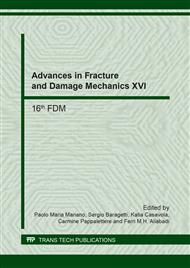p.325
p.329
p.333
p.337
p.341
p.345
p.349
p.353
p.359
New Insights into the Anchorage Zones of Precast Pretensioned Concrete Girders
Abstract:
Pretensioned concrete girders are widely used in the construction sector. Nevertheless, optimisation is still possible considering the end zones. These end zones are subject to different types of stress due to the local transmission of the prestress force. In order to optimise these regions, a 3D non-linear finite element model was developed using the Abaqus software. Different from other attempts, a full scale girder with multiple strands is modelled. The accuracy of the FE model was verified by comparing the numerical results with experimental data. A full scale test in a precast concrete plant during normal production is carried out, and a good fit between the experimental and numerical results is obtained. Finally, the model was used to design a girder without end block. The calculation of the additional reinforcement was based on vector plots of the tensile stresses, extracted from the FEM.
Info:
Periodical:
Pages:
341-344
Citation:
Online since:
September 2017
Authors:
Keywords:
Price:
Сopyright:
© 2017 Trans Tech Publications Ltd. All Rights Reserved
Share:
Citation:


